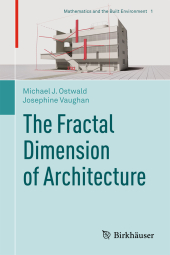 Neuerscheinungen 2016Stand: 2020-02-01 |
Schnellsuche
ISBN/Stichwort/Autor
|
Herderstraße 10
10625 Berlin
Tel.: 030 315 714 16
Fax 030 315 714 14
info@buchspektrum.de |

Michael J. Ostwald, Josephine Vaughan
(Beteiligte)
The Fractal Dimension of Architecture
1st ed. 2016. 2016. xvii, 423 S. 202 SW-Abb. 235 mm
Verlag/Jahr: SPRINGER, BERLIN; SPRINGER INTERNATIONAL PUBLISHING 2016
ISBN: 3-319-32424-1 (3319324241)
Neue ISBN: 978-3-319-32424-1 (9783319324241)
Preis und Lieferzeit: Bitte klicken
Fractal analysis is a method for measuring, analysing and comparing the formal or geometric properties of complex objects. In this book it is used to investigate eighty-five buildings that have been designed by some of the twentieth-century´s most respected and celebrated architects. Including designs by Le Corbusier, Eileen Gray, Frank Lloyd Wright, Robert Venturi, Frank Gehry, Peter Eisenman, Richard Meier and Kazuyo Sejima amongst others, this book uses mathematics to analyse arguments and theories about some of the world´s most famous designs.
Starting with 625 reconstructed architectural plans and elevations, and including more than 200 specially prepared views of famous buildings, this book presents the results of the largest mathematical study ever undertaken into architectural design and the largest single application of fractal analysis presented in any field. The data derived from this study is used to test three overarching hypotheses about social, stylistic and personal trends in design, along with five celebrated arguments about twentieth-century architecture. Through this process the book offers a unique mathematical insight into the history and theory of design.
1.Introduction.- Part I: Understanding and Measuring Fractal Dimensions.- 2.Fractals in Architectural Design and Critique.- 3.Introducing the Box-Counting Method.- 4.Measuring Architecture.- 5.Refining and Understanding the Method.- Part II: Measuring Twentieth Century Architecture.- 6.Analysing the Form of the Twentieth Century House.- 7.The Rise of Modernity.- 8.Organic Design.- 9.Post-Modernism.- 10.Avant-Garde and Abstraction.- 11.Minimalism and Regionalism.- 12.Conclusion.- References.- Acknowledgments.
"This book is a case-study ... displaying its strengths and weaknesses in testing hypotheses regarding the architecture of 85 homes from four continents designed by prominent architects between 1901 and the present day. ... Mathematicians will enjoy reading the results of the application of the box-counting method ... . the text is both well-written and remarkably error free ... . Thank you, authors and editors!" (Joel Haack, MAA Reviews, February, 2018)
"The authors give valuable critical thoughts about a few sensitive problems that researchers face when they use fractal dimension for analyzing images. ... 625 architectural plans and elevations (derived from the 85 buildings) are considered and interesting conclusions from the fractal and statistical analysis performed are brought to the reader´s attention." (Elena Hadzieva, Mathematical Reviews, September, 2018)
"It is written by experts who have published a lot on this particular subject on the boundary of architecture and mathematics. ... this book is in the first place addressing architect students or researchers ... . All the elements of the research methodology, hence also the fractal dimension, are clearly and extensively explained and motivated. Also the analysis of the results and conclusions are carefully described. So it is easy to read and understand for anyone interested in the topic." (Adhemar Bultheel, European Mathematical Society, euro-math-soc.eu, December, 2016)


